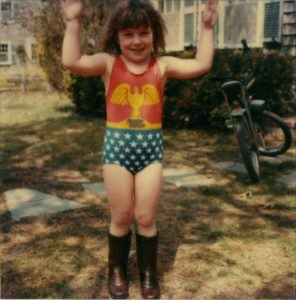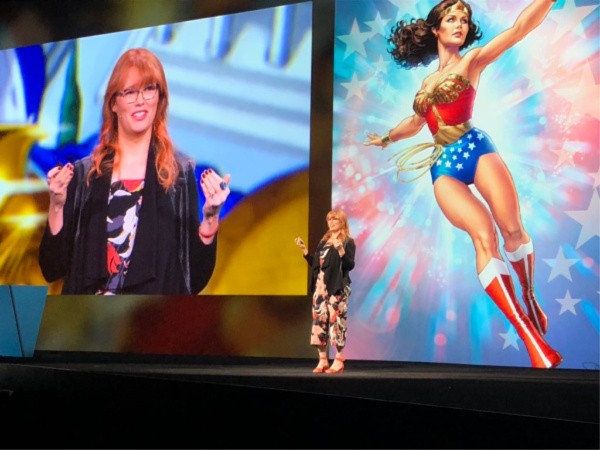By Kerry Gorgone, {grow} Contributing Columnist
Last week, Adobe brought me out to Los Angeles to attend a conference with 14,000 people whose jobs are safe (theoretically) from being taken over by robots: Adobe MAX, The Creativity Conference. As marketers and other professionals worry about what automation, machine learning, and artificial intelligence might mean for their jobs, creative roles seem to remain above the fray. Artificial intelligence isn’t yet sophisticated enough to replace human creative expression.
That doesn’t mean, though, that technology can’t enhance and facilitate creativity. Speakers like director and producer Ron Howard, musician Questlove, and YouTuber Lilly Singh shared their insights on the creative process. Here’s what I learned.
1. Inspiration can’t strike unless you sit still.
I hadn’t expected a musician to talk about the importance of silence, so I was surprised when Questlove talked about how you need to “allow yourself to be in silence,” thereby opening up space for creative inspiration. “The most important part of creativity,” he says, “is boredom.”
Similarly, YouTuber Lilly Singh makes room for inspiration. She schedules breaks from her content creation schedule to consume others’ content, drawing inspiration from movies, books, TV shows, and more.
When I was a little girl, “Wonder Woman” was my favorite TV show. I wanted to be Wonder Woman. Seriously. I used to introduce myself to people as Wonder Woman while wearing my Wonder Woman Underoos with my winter boots and carrying a piece of rope tied into a lasso. Check it out.

That’s one reason I was incredibly excited to hear comic book artist Nicola Scott speak: she draws Wonder Woman!
Scott’s remarks really inspired me. When she was young, she’d wanted to be an actress. When that hadn’t worked out, she considered whether she might make a career with her talent for drawing.
“Instead of asking ‘what can I do with drawing,’ she explained, “I asked myself, ‘what do I want to draw?’ One second I’m thinking ‘why can’t I draw Wonder Woman every day?’ And the next I realized that IS a job! ‘I’m going to draw comic books!’”
2. If you love writing/drawing/anything just start.
Your creative work is content marketing for your career. As Scott experienced, “writers started seeing my work online and asking their editors about me, and I had no idea.” Eventually, this grassroots content marketing effort of posting her art online got her recruited to draw for Black Magick. Today, she draws Wonder Woman, as well as working on many other female characters.
Thinking back on my nontraditional career path (marketer to lawyer to professor to interviewer and trainer), people were largely dismissive of my more creative aspirations. Parents, advisors, and even well meaning friends would push me towards a more traditional path. “But won’t you miss the prestige of being a lawyer,” they’d ask (which always made me chuckle) or “but you’ve already got your law license — it’d be a shame not to practice.”
That’s why Ron Howard’s words really resonated with me: “Understand that your creativity has value. You’re not wasting your time dreaming. All of us have creative strength and power.”
By accepting that creativity is valuable in and of itself, I was able to make the leap from lawyer to educator, then again from educator to podcaster and trainer.
But creativity doesn’t just hold value for individuals: it can power entire organizations.
3. Creative thinking enhances customer and user experience.
Inspiration and creativity might seem far removed from the c-suite, but they’re not. Executives at smart companies understand the importance of innovation and creativity, and are working hard to enhance the user experience of their customers.
According to Jaco Van Eeden of HCL Digital & Analytics, customer experience about changing business, changing the way people interact with their jobs, and providing an unmatched customer experience.
“It’s a mindset first,” he observes. “When we think about creating something completely new, the mindset has to lead. If you don’t have the mindset to think through outcomes and purpose, and frame the problem, you can’t get it right.” He’s right.
Innovation without direction seems unlikely to succeed in improving customer or user experience.
Some people don’t draw a meaningful distinction between CX and UX, but the two concepts are distinct. When I spoke with Capgemini’s UX Practice Head, Monica Deshpande, she explained how user experience and customer experience interrelate.
“When you look at customer experience as a whole, we’re talking about brand value, how the end user interacts with the entire brand,” explains Deshpande. “User experience is always extrapolated into the customer experience.”
Focusing on customer experience or user experience will benefit your business, but paying careful attention to both can exponentially improve results. An optimized customer experience along the buying path will increase conversions, but those people won’t stick around if your user experience fall short. UX and CX are not the same thing and they’re not mutually exclusive: you need to understand and prioritize both.
4. Don’t lose sight of the bigger picture.
As Louis Marino, executive creative director at IT company Cognizant cautions, don’t get too mired down by the data. “We can get lost in the data very quickly,” he explains. “When a client comes up to us with a problem, the first thing we do is say ‘yes, we’ll look at your data, but we really want to be able to talk to the people—not the stakeholders or the executive sponsors—the end user.”
Understanding the audience you’re trying to reach is key to enhancing the customer experience. It seems so simple, but in our relentless pursuit of attributable marketing ROI, it’s easy to forget entirely that the purpose of marketing (and our business as a whole) is to serve others. Giving the people what they want is impossible unless you first listen to them.
You can’t do your best work unless you know why you’re doing it, and for whom.
My key takeaways:
- Make room for inspiration.
- Use your own creative work as content marketing for your career.
- Creativity and inspiration are good for customer and user experience.
- Remember to look up from your data now and then to refocus on your end users.
We can’t do our best work individually unless we tap into our creativity. It follows, therefore, that companies can’t produce the best possible product (or marketing) unless the individuals who work there tap into their creativity.
Invest in creating an environment where creativity thrives. You’ll see that it pays off!

Kerry O’Shea Gorgone is a writer, lawyer, speaker and educator. She’s also Director of Product Strategy, Training, at MarketingProfs. Kerry hosts the weekly Marketing Smarts podcast. Find Kerry on Twitter.



